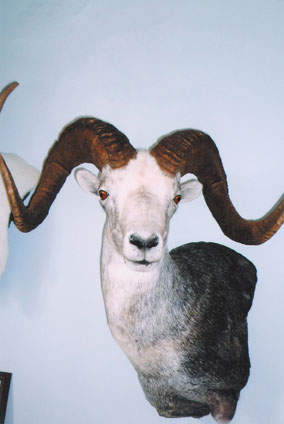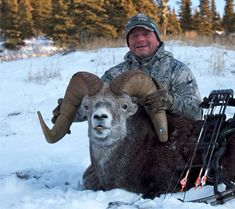
The Best Shot I’ll Ever Make: Fred Bear’s World-Record Stone Sheep, From the Archives
It’s easy to forget that legends were once just people. Fred Bear’s story is often retold, but details can get lost over time, turning our heroes into myths.
I first heard this story in an anniversary book from Outdoor Life, but it wasn’t until I read the April 1960 issue that I truly experienced it. The printed words and the smell of aged magazine paper transported me back in time.
The world-record stone sheep taken by Fred Bear is an incredible tale that reveals the humanity behind the legend. He was a legendary bowhunter, but also a salesman who promoted his Bear Razorhead broadheads.
Bear had a code of ethics that diverged from the beliefs of his online followers today. Some of his shots and advocacy would be highly criticized in the internet age. The shot discussed in this story was reckless, and Bear was lucky to recover his sheep. Despite everything working out, it’s clear that the decision weighed heavily on him. It speaks volumes about the man and how he became a legend. —Tyler Freel
Cover of the April, 1960 issue of Outdoor Life
Best Shot I’ll Ever Make
By Fred Bear, as told to Bryon W. Dalrymple
A Memorable Stalk
Knick was stalking below us, and it seemed like he would succeed. I grabbed my camera and told my guide, Charles Quock, to stay with the horses. I rushed to a spot with a clear view of the goats and set up my camera on a tripod.
I waited, watching, and eventually Knick appeared. He was doing an excellent job, moving closer and closer. The goats were bedded just below a big rock, creating the perfect setup.
When he reached 35 yards, a gunner might have taken the shot from above. But for us archers, getting close was essential. Knick, Elisha Gray, Ed Henkel, and I were all archers, and getting in close was an important part of the sport for us.
With the goats becoming aware of the danger, Knick drew his bow and took the shot. It was a perfect hit. One goat fled while I operated the camera, running about 200 yards before falling and disappearing into some brush.
Knick decided not to follow immediately. We talked excitedly and ate lunch while giving the animal plenty of time. Eventually, we worked our way down and found Knick’s trophy waiting—a fine specimen with 10-inch horns.
I began to reflect on the unpredictable nature of hunting, especially when it came to sheep. We had traveled thousands of miles to hunt Stone sheep in northern British Columbia, one of the best spots on the continent. Yet, we hadn’t seen a single sheep since our arrival. However, I was reminded that patience is a hunter’s most valuable asset.
The Elusive Stone Sheep
Stone rams are highly sought-after trophies due to their long and elegant horns. They also vary in color, which has led to debate among scientists about the true number of sheep species in North America.
While sportsmen recognize four species of North American sheep, scientists often group them into two or even one super-species. In the region we were in, all but the pure white ones were referred to as Stone sheep by sportsmen.
I had come a long way from Grayling, Michigan, to hunt in northern British Columbia. The area was a vast wilderness with towering peaks, glaciers, and diverse wildlife. I was eager to begin the hunt.
Pursuing a Grizzly Bear
On September 13, we spotted a magnificent grizzly bear. The previous year, I had hunted and successfully taken a grizzly with my bow in the Yukon, so this sighting intrigued me. We attempted to stalk the bear but ultimately lost sight of it.

Later, while scanning the mountainside, we noticed something moving. It was the grizzly again, foraging on berries. As we observed the bear, I couldn’t help but think about the abundance of game we had encountered on our hunt, except for the elusive sheep.
Our Luck Turns Around
During our hunt, we stumbled upon a group of nine Stone rams in a breathtaking display. We watched as they skillfully navigated a narrow crevice, known as a “sheep stairway,” in the face of a cliff. It was a sight very few have witnessed.
Excited by our discovery, Charles and I continued our hunt. We encountered moose, ptarmigan, and more goats. However, still no sheep. It wasn’t until we spotted a lone ram in the distance that our luck finally changed.
We carefully closed the distance, eventually reaching a spot about 50 yards away from the ram. It was a full-curl ram, a magnificent specimen. As he stood there, looking straight at us, I realized that this was the moment I had been waiting for.
I took a calculated shot, aiming to lob the arrow over the ridge and into the ram’s chest. It was a risky shot, but I couldn’t hesitate after all the effort we had put in. To my relief, Charles spotted blood and confirmed a successful hit.
We pursued the ram further, engaging in a thrilling chase up and down the mountainside. In the end, we triumphed, and I claimed a beautiful Stone ram—a truly remarkable trophy and a new record for a white man hunting with a bow.
Fred Bear, with his magnificent Stone sheep, rolled it down the mountain. (Outdoor Life, April, 1960, Tyler Freel)
I examined the arrow wound – a gaping hole in the middle of the brisket. Never seen a more devastating wound. The arrow cut neck veins, skidded between rib cage and shoulder blade, shed its insert blade, and passed out through a slit behind the front leg. We looked, but never found the 28-inch fiberglass arrow.
Undoubtedly, I was lucky with this shot. Probably the best shot I’ll ever make.
We left our hats back, rocks on them to keep them from blowing away. Charles went back for them.
As he left, he said, “Roll him down the mountain.”
I was reluctant. “That’ll break the horns.”
Charles chuckled. “Goat horns brittle, sheep not.”
He left, and I rolled the ram. It tumbled about 400 yards down the slope and came to rest on a bench. Charles returned, and we worked our way down. The horns were undamaged. I was relieved. Charles grinned and gave it another nudge. This time, it rolled a quarter of a mile, down to where we could get it with the horses.
Charles dressed out the ram, and we took pictures. It was 4:30 p.m. and raining. We went back to our saddle horses and headed for camp – four hours away. We’d come up the next day with a pack animal to take the sheep out.
The next morning, shortly after sunrise, I saw a grizzly on the mountainside from camp. I watched through the scope.
Charles came up and asked, “You want to hunt grizzly bear?”
“Just want to look, Charles,” I said. “Sheep is enough. I know I’ll never be able to repeat yesterday’s shot.”
More stories from Outdoor Life archives
- Frozen Terror: One of the Greatest Survival Stories from Our Archives
- Arrow for a Grizzly: A Classic Fred Bear Tale from the Archives
- Will Wolves Attack a Man? A Frank Glaser Story from the Archives

A skilled hunter, dedicated conservationist, and advocate for ethical practices. Respected in the hunting community, he balances human activity with environmental preservation.
